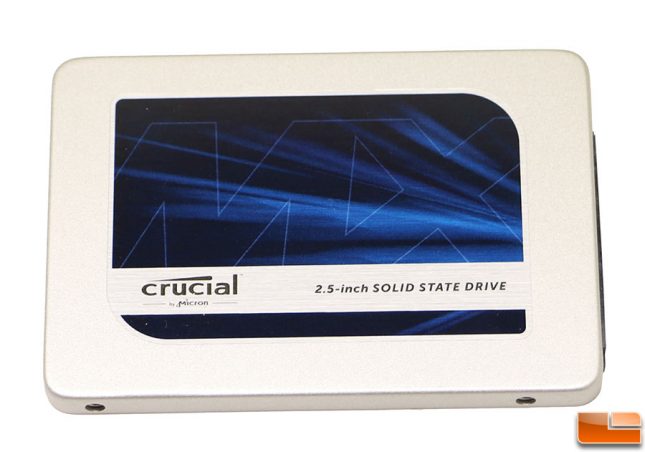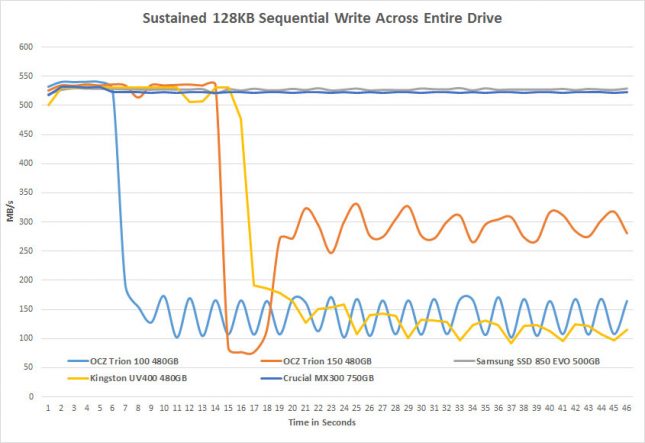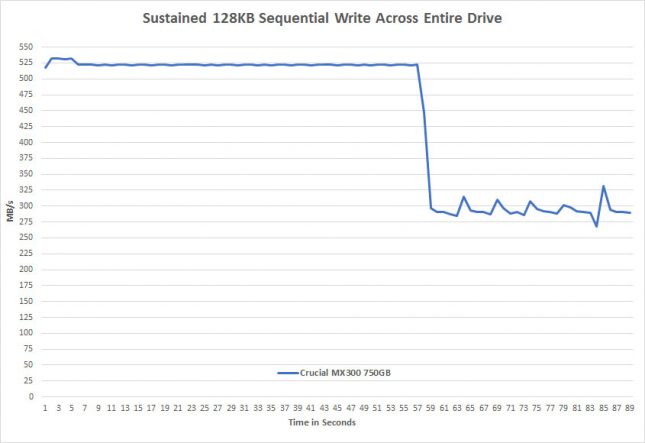Limited Edition 750GB Crucial MX300 SSD Review
Taking A Look At The SLC Cache Sustained Write Performance
Triple-Level Cell TLC NAND based SSDs perform usually quite well, but when you copy a large amount of data to the drive without and idle time you’ll often find a large drop in write speed. TLC NAND is great in applications where write operations are limited , but is usually not recommended for critical systems that have heavy write operations as they have lower endurance ratings than SLC or MLC NAND and of course sustained write performance isn’t stellar. In recent years drive manufactures have been figured out that by using SLC or TLC treated as SLC as a cache they can keep the drives overall write performance high as long as the amount of data being written to the drive fits in the cache. If you overflow the cache, you are then writing directly to the TLC NAND and the write performance will drop down to that level. It should be noted that the SLC cache will clear once the drive idles, so this only impacts long writes that are many GB in size. This might not be a typical workload scenario for this ultra-value or mainstream drives, but still something worth pointing out!
When you average the test results over the 45 second period that we are focusing on these are the average speeds that you come up with:
- Samsung SSD 850 EVO 500GB – 527.23 MB/s
- Crucial MX300 750GB SSD – 522.4 MB/s
- OCZ Trion 150 480GB – 347.75 MB/s
- Kingston UV400 480GB – 267.04 MB/s
- OCZ Trion 100 480GB – 192.19 MB/s
The Crucial MX300 750GB Limited Edition drive does pretty well here, but we noticed that a number of seconds later that performance did indeed drop like many of the other TLC drives.
The good news is that it wrote over 30GB of data to the drive in the 57 seconds that the drive performed at near rated write speeds! After nearly a minute of sustained writes the performance of the drive dropped down in the 268MB/s to 331MB/s range for the remainder of our test where the data is being written directly to the Micron . This is a ton of data to write to a drive without any break, so Crucial has really worked some magic here as this is certainly one of the best TLC drives that we have ever seen with regards to sustained write speeds. We asked Crucial about how they were able to pull this off and got the following answer from the company.
“We have made some changes to the Dynamic Write Acceleration (DWA) implementation that is different than MX200. DWA has been optimized for common client computing environments, where data writing operations tend to occur in bursts, offering the increased performance without decreasing user capacity. Additionally, the base TLC speed of our 3D is greatly improved over previous generations, so even direct to TLC writes remain quite fast. up to 1/3 of the drive can be assigned as SLC, but in writes that go larger than 30GB or so, writes will transition temporarily to TLC while data is moved from the SLC to TLC space and things are cleaned up for the next operation.” – Crucial PR
It looks like the changes to DWA along with the new controller and Micron 16nm 3D TLC NAND are certainly working out very well for them! Crucial also informed us that up to 1/3 of the drive can be assigned as SLC, but in writes that go larger than 30GB or so, writes will transition temporarily to TLC while data is moved from the SLC to TLC space and things are cleaned up for the next operation. This explains why we are directly writing to the TLC after 30GB of writes were completed to the the drive.
Let’s take a look at some common benchmarks!



